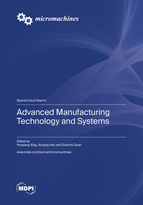Advanced Manufacturing Technology and Systems
A special issue of Micromachines (ISSN 2072-666X). This special issue belongs to the section "E:Engineering and Technology".
Deadline for manuscript submissions: closed (10 June 2022) | Viewed by 42468
Special Issue Editors
Interests: tool coatings; green machining; additive manufacturing, micro/nano machining
Special Issues, Collections and Topics in MDPI journals
Interests: micromachining processes; functional micro-textured surfaces and applications
Special Issues, Collections and Topics in MDPI journals
Interests: grinding process; smart manufacturing and systems; precision machine
Special Issues, Collections and Topics in MDPI journals
Special Issue Information
Dear Colleagues,
Advanced manufacturing technology and systems (AMTS) combine principles of mechanical engineering with design innovation to create products and processes that are better, faster and more precise. The core of AMTS is the design, fabrication, and application of original and effective solutions related to manufacturing machines, process integration and systems to keep up with the dynamic needs of today's ever-evolving industries. In this Special Issue, we seek papers in advanced manufacturing technology that cover a broad scope involving manufacturing processes, machine tool design, additive manufacturing, smart and flexible manufacturing, theoretical study and metrology. In addition, multidisciplinary (physical, chemical, micro/nano and biomedicine) manufacturing technologies and systems are welcome, including micro-/nanofabrication, nanomaterial processes, biomedical fabrication, etc. All types of papers, such as original research papers and review articles, are welcome.
Prof. Dr. Youqiang Xing
Prof. Dr. Xiuqing Hao
Prof. Dr. Duanzhi Duan
Guest Editors
Manuscript Submission Information
Manuscripts should be submitted online at www.mdpi.com by registering and logging in to this website. Once you are registered, click here to go to the submission form. Manuscripts can be submitted until the deadline. All submissions that pass pre-check are peer-reviewed. Accepted papers will be published continuously in the journal (as soon as accepted) and will be listed together on the special issue website. Research articles, review articles as well as short communications are invited. For planned papers, a title and short abstract (about 100 words) can be sent to the Editorial Office for announcement on this website.
Submitted manuscripts should not have been published previously, nor be under consideration for publication elsewhere (except conference proceedings papers). All manuscripts are thoroughly refereed through a single-blind peer-review process. A guide for authors and other relevant information for submission of manuscripts is available on the Instructions for Authors page. Micromachines is an international peer-reviewed open access monthly journal published by MDPI.
Please visit the Instructions for Authors page before submitting a manuscript. The Article Processing Charge (APC) for publication in this open access journal is 2600 CHF (Swiss Francs). Submitted papers should be well formatted and use good English. Authors may use MDPI's English editing service prior to publication or during author revisions.
Keywords
- additive manufacturing
- computer-integrated manufacturing systems
- green manufacturing
- machining and forming technology
- micro- and nanofabrication
- precision engineering
- smart manufacturing
- non-traditional manufacturing processes
Related Special Issues
- Advanced Manufacturing Technology and Systems, 2nd Edition in Micromachines (33 articles)
- Advanced Manufacturing Technology and Systems, 3rd Edition in Micromachines (7 articles)








